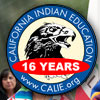 |
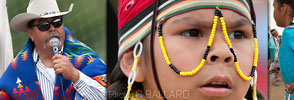 |
 |
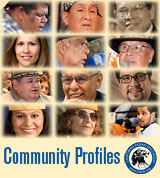


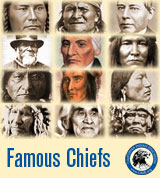

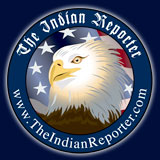

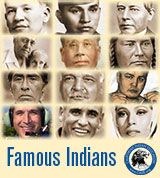


Publishing Corner: Indian Community: Science & Wonder Indian Heros: California Indian Art: CALIE Library: Academic Financial Aid: Tribal Governments: Indian Gaming: |
July 4, 2011: Native American Warriors
During the American Revolution and the War of 1812: Tyonajanegen, an Oneida Indian, distinguished herself at the battle of Oriskany during the American Revolution, fighting alongside her husband of Dutch descent. Sacajawea, a Shoshone woman, guided Lewis and Clark on their expedition west.
In the Civil War (both for the Union and Confederacy), scouting skills of American Indian soldiers were exploited and rarely acknowledged. North and South both appointed Indians to be Generals in their Army.
Here is a list of Native American Medal of Honor recipients, 1872-1890: Alchesay. Sergeant, Indian Scouts. Place and date: Winter of 1872-73. Entry of service date unknown. Entered service at: Camp Verde, Arizona. Born: 1853, Arizona Territory. Date of issue: 12 April 1875. Citation: Gallant conduct during campaigns and engagements with Apaches.
Nannasaddie. Indian Scout. Place and date: 1872-73. Entry of service date unknown. Birth: Arizona. Date of issue: 12 April 1875. Citation: Gallant conduct during campaigns and engagements with Apaches. In 1866, the Indian Scouts were established by the U.S. Army. In one year later 474 Indians were serving in the US military. American Indian soldiers accompanied Teddy Roosevelt to Cuba as Rough Riders in the Spanish-American War. The American Indian Scouts accompanied Gen. Pershing and Lt. Patton to Mexico in pursuit of Poncho Villa in 1916. The Indian Scouts were an integral part of the Army until they were disbanded in 1947.
Four American Indian nuns worked as nurses for the War Department in Cuba during the Spanish-American War. World War I: About 12,000 American Indians served during WW I. About 600 Oklahoma Choctaw and Cherokee men served in the Texas 124th Infantry. They saw action in France, and were recognized by France and the US for their combat skills and bravery. Four American Indians were awarded the Croix de Guerre, France’s highest military honor, for their valor. Fourteen American Indian women served in the Army Nurse Corps.
The Choctaw and Comanche language was used in Europe to code messages to confuse German code-breakers. In 1919, American Indian soldiers and sailors were granted U.S. citizenship, five years before the 1924 Snyder Indian Citizenship Act granted citizenship to all American Indians. World War II: Nearly 20 percent of the American Indian population, both men and women, were either in the armed forces or working for the war effort on the home front. Six American Indians earned the Congressional Medal of Honor for service during WW II. Lt. Emest Childers (Creek) and Lt. Van Barfoot (Choctaw) of the famed 45th "Thunderbird" Infantry Division-won Medals of Honor in Europe. Childers had first distinguished himself in Sicily, where he received a battlefield commission. Later in Italy, unaided and despite severe wounds, he destroyed three German machine gun emplacements. During the breakout from Anzio to Rome, Barfoot knocked out two machine gun nests and captured seventeen prisoners. Subsequently, he defeated three German tanks and carried two wounded men to safety. More than 44,000 American Indians served in the military from 1941 to 1945, including 800 women. An estimated 99 percent of healthy male American Indians ages 21 to 44 were registered for the draft. Para marine Ira Hayes, an Oodham-Pima Indian from Arizona, was one of six marines to raise the flag on Mt. Suribachi in Iwo Jima. The Navajo language was used to code messages in the Pacific theater of operations. Over 400 Navajo “Code Talkers” served in the Marine Corps by war’s end.
Korean War: Four American Indians were awarded the Congressional Medal of Honor. More than 10,000 American Indians served during the Korean War. Among notable American Indians serving during the Korean War were former Colorado Senator Ben Nighthorse Campbell and Vice Admiral Joseph “Jocko” Clark, a Cherokee, who was commander of the Navy’s 7th fleet during the war. Vietnam War: More than 42,000 American Indians served in the Armed Forces between 1965 and 1975. The Senator Matsunaga Project, as mandated in Public Law 101-507, studied Post-Traumatic Stress Disorder (PTSD) among American Indian Vietnam veterans. The study found relatively high levels of emotional problems from exposure to combat, stress, PTSD and agent orange. Bosnia-Somalia-Gulf War During the Desert Storm conflict more than 3,000 American Indians served in the Gulf region. Several American Indians lost their lives in the Gulf War, including Lori Piestewa, a Hopi Indian from Arizona, who died in the ambush in which Jessica Lynch and her compatriots were captured. Squaw Peak in Arizona was officially re-named Piestewa Peak in her honor. As of 1980, at least 60 women served as Eskimo Scouts in the Alaska National Guard, patrolling the western Alaska coastline. The Scouts, organized during WW II, represent the only unit of the Alaska Guard to have a continuous active duty mission. American Indians in current Military Active Duty: The latest data from the Department of Defense (July 2005) show that more than 24,000 among 1.4 million active duty military are American Indians,3 including nearly 3,900 women. American Indians represent roughly two percent of the active duty force. By branch, the distribution of American Indians differs from the distribution of the overall active duty military, as shown below: American Indians are also “over-represented compared to other ethnicities” in the Marines (20% v. 13% of all active duty) and “under-represented” in the Army (19% v. 34%) and Air Force (12% v. 25%). Among American Indians in the active duty military, nearly one-half are in the Navy, compared to one-quarter of all active duty members. It is estimated that American Indians males in the active duty military represent more than 3 percent of all American Indian males 20 to 44 years old. It is estimated that among all males 20 to 44, 2 percent are in the active duty military. This continues a trend which indicates that American Indian males serve in greater proportion than eligible males in general. This includes Desert Storm/Shield and Operations Enduring Freedom, Iraqi Freedom and Afghanistan. The DOD number is somewhat understated in that American Indians of mixed ancestry (that is, those who are of another race or races as well as American Indian) are not included. The number includes members of the Coast Guard as well as DOD branches. Source: DOD
Native American stories are brought to you by Southern California American Indian Resource, SCAIR.
|
CALIF INDIAN EDU NETWORK: AHMIUM.org | SCAIR.org | SDICENTER.org | APAPAS.com
—
WEB SITE DESIGN
www.calie.org COPYRIGHT 2008-Present • ALL RIGHTS RESERVED

 The fourth of July is a United States federal holiday. It is observed the first week of July. This is a fine time to recognize the military service of our Federal, State and non- government recognized Tribal American Indian Warriors. We have always defended this great land for all the people. We appreciate and Honor our Military Veteran Warriors whom have stood on the line in combat to defend this land and our Indian Nations.
The fourth of July is a United States federal holiday. It is observed the first week of July. This is a fine time to recognize the military service of our Federal, State and non- government recognized Tribal American Indian Warriors. We have always defended this great land for all the people. We appreciate and Honor our Military Veteran Warriors whom have stood on the line in combat to defend this land and our Indian Nations.

 In the disgraceful and treaty breaking ‘Indian war’ period, 16 American Indian Scouts were awarded the military’s highest honor, the Congressional Medal of Honor:
In the disgraceful and treaty breaking ‘Indian war’ period, 16 American Indian Scouts were awarded the military’s highest honor, the Congressional Medal of Honor:




